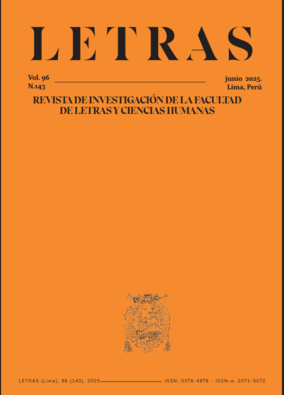The reform of the Hospice of Nuestra Señora de Atocha in Lima during the Eighteenth Century
Abstract
The historiography's approach to the church of the Hospice of Nuestra Señora de Atocha (Lima) has been extensive, pointing out the similarities with Borromini's models and opening debates about the consequences of the 1746 earthquake and the design of the church. A recent study by Gauvin Alexander Bailey, published in the Burlington Magazine, has revitalized those debates about the building. Nevertheless, there is a lack of information about the hospice and the church before the decade of the1740s. The article will be based on the report of 1720 by the architects Íñigo de Eraso and Eugenio de Atienza and their proposals for the hospice and church, viewed in relation to the later reforms. Aspects such as the improvement of health, changes in the configuration of the building or the condition of the church will be examined. Moreover a plan for the hospice drawn up by a military engineer under the viceroyalty of Manuel de Amat will be analyzed regarding the importance of the military engineers and the application of a new architectural language. The unpublished documents and plans found allow a better knowledge of the building and its architecture. This documentation comes from various institutions: the General Archive of the Indies, the British Library, and the Library of Catalonia.Downloads
Métricas alternativas
References
Álvarez Ortega, S. P. (2022). Estrategias de diseño bioclimático en la arquitectura residencial colonial limeña. [Tesis de Maestría en Ciencias con mención en Energías Renovables y Eficiencia Energética] Universidad Nacional de Ingeniería. http://hdl.handle.net/20.500.14076/22960
Bailey, G. A. (2022). A Borromini-inspired church plan in eighteen century Lima. The Burlington Magazine 164(1433), 740-751
Barrera Camarena, H. (2017). Breve historia de una casa colonial limeña. Puesta en valor del patrimonio edificado. Revista del Archivo General de la Nación 32(1), 73-83. https://doi.org/10.37840/ragn.v32i1.8
Batiz, P. (2003). Los vascos en la colonización del Perú. En J-C. Larronde, VII Congreso de Estudios Vascos (pp. 455-457). Eusko Ikaskuntza.
Bayón, D. y Marx, M. (1989). History of South American Colonial Art and Architecture. Ediciones Polígrafa.
Bernales Ballesteros, J. (1972). Lima, la ciudad y sus monumentos. Escuela de Estudios Hispanoamericanos.
Chuhue Huamán, R. (2009). Orfandad, asistencialismo y caridad cristiana en Lima Colonial: Historia de la Iglesia de Niños Huérfanos de Lima. Revista del Archivo General de la Nación 27, 143-164. https://revista.agn.gob.pe/ojs/index.php/ragn/issue/view/11
Chuhue Huamán, R. (2014). Enterramientos de expósitos y benefactores en la bóveda sepulcral de la iglesia y hospicio de niños huérfanos de Lima. En R. Chuhue Huamán y P. van Dalen (Eds.), Lima Subterránea. Arqueología histórica. Criptas, bóvedas, canales virreinales y republicanos (pp. 101-122). Fondo Editorial de la Universidad Nacional Mayor de San Marcos.
Chuhue Huamán, R. (2016). Una corporación poco conocida: la Hermandad de Nuestra Señora de Atocha de escribanos limeños en el siglo XVII. Revista del Archivo General de la Nación 31(1), 39-70. https://doi.org/10.37840/ragn.v31i1.28
Crespo Rodríguez, M. D. (2020). Arquitectura Doméstica de la Ciudad de los Reyes (1535-1750). Universidad de Sevilla y Consejo Superior de Investigaciones Científicas.
Fohn, M. (2016). Excavaciones arqueológicas en la Casa Bodega y Quadra en el centro histórico de Lima. Boletín de Arqueología PUCP 21, 145-162. https://doi.org/10.18800/boletindearqueologiapucp.201602.009
Gisbert, T. y Mesa, J. (1997). Arquitectura andina, 1530-1830. Embajada de España en Bolivia.
Guzmán Quintana, Y. K. (2018). Sustainability analysis of a colonial vernacular housing in the historical center of Lima. Building & Management 2(3), 8-23. https://doi.org/10.20868/bma.2018.3.3838
Harth-Terré, E. (1942). La iglesia del Sagrado Corazón de Jesús. El Arquitecto Peruano (54), sin paginar.
Harth-Terré, E. (1945). Artífices en el virreinato del Perú. Imprenta Torres Aguirre.
Hernández García, R. (2005). El bien invisible. Una aproximación a la consideración de los niños durante el período virreinal en América hispana. Diálogo Andino 26, 15-40.
Mannarelli, M.E. (2004). Pecados Públicos. La ilegitimidad en Lima, siglo XVII. Heinrich Böll Stiftung. https://repositorio.unal.edu.co/handle/unal/75362
Marussi Castellan, F. (1986). Bóvedas a base de quincha en las edificaciones monumentales del virreinato del Perú. Informes de la construcción 37(377), 59-66. https://informesdelaconstruccion.revistas.csic.es/index.php/informesdelaconstruccion/article/view/1789
Mattos-Cárdenas, L. (2016). El plano inédito de la ‘casona’ de San Marcos y la obra de Cristóbal de Vargas (siglo XVIII). El ‘módulo b-a-b’ y su recuperación. devenir 3(5), 28-44. https://doi.org/10.21754/devenir.v3i5.230
Rivasplata Varillas, P. E. (2021). Insertando a huérfanas de ascendencia española en la sociedad limeña por medio de dotes del Colegio Santa Cruz en el siglo XVII. Fronteras de la Historia 26(2), 216-236. https://doi.org/10.22380/20274688.1347
San Cristóbal, A. (2009). Arquitectura firme del siglo XVIII en Lima. Instituto de Investigación de la Facultad de Arquitectura, Urbanismo y Artes de la Universidad Nacional de Ingeniería.
San Cristóbal Sebastián, A. (2011). Arquitectura virreinal religiosa de Lima. Universidad Católica Sedes Sapientiae.
Scaletti Cárdenas, A. (2015). “…haviendo reconocido su fábrica de adovería y telares...”: La casa Riva-Agüero (Lima, Perú - siglo XVIII). Actas del Noveno Congreso Nacional y Primer Congreso Internacional Hispanoamericano de Historia de la Construcción 3, 1591-1601.
Toribio Medina, J. (1958). Historia de la Imprenta en los antiguos dominios españoles de América y Oceanía. Tomo I. Edición digital: https://www.cervantesvirtual.com/nd/ark:/59851/bmc2j6b1
Wethey, H. E. (1949). Colonial Architecture and Sculpture in Peru. Harvard University Press.
Wieser Rey, M. (2012). Desempeño térmico y lumínico de las Teatinas limeñas. Ciudad y Arquitectura 5(1), 75-82.
Copyright (c) 2025 Letras (Lima)

This work is licensed under a Creative Commons Attribution 4.0 International License.
Este obra está bajo una licencia de Creative Commons Reconocimiento 4.0 Internacional



















